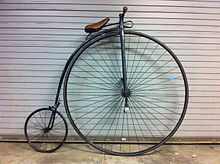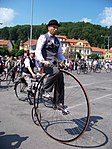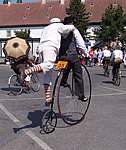Penny farthing

AB: Saddle and contact point of the front wheel
AC: Saddle and rear wheel
AD: Direction of gravity
Since the contact point of the tire is only slightly in front of the center of gravity, there is a high risk of falling - especially when driving downhill, braking or hitting an obstacle.
The high wheel is a type of bicycle that is characterized by a special size of the front wheel and is only moved by means of the pedals mounted directly on the wheel axle. It was developed from the Michauline , which is also operated by a pedal crank . Between 1870 and 1892 around 200,000 high bikes were manufactured. In the English-speaking world, the penny-farthing was called Ordinary , and the term penny-farthing did not emerge until the decline around 1890 , as the size ratio of the front and rear wheel corresponded to the penny and farthing coins.
The massive wooden spokes of the Michaulinen were replaced with thin wire spokes and the iron race with solid rubber. The spokes subjected to tensile loading made the front wheel larger without any significant increase in weight. Due to the larger rolling circumference with the same pedal crank speed ( unfolding ) and better ride comfort, the penny farthing quickly prevailed over its predecessor. Due to the size of the wheel, the driver moved forward and thus up. The more difficult getting on and off the bike, the greater risk of accidents and the worse consequences of the accident due to the height of the seat and thus the height of the fall , have been and are considered disadvantages of the high-bike . In Great Britain it became the sporting equipment and status symbol of young, wealthy men who were on par with aristocratic riders. The Franco-Prussian War and its aftermath caused an economic crisis on the continent , which affected the further development of the bicycle. In 1885 the safety low wheel was created , which began to displace the high wheel within a short time.
In the 20th century, the penny farthing was given the status of an antiquated collector's item. As such, it is still important to collectors today.
technology
High wheels are typically (101.6 to 152.4 cm) in diameter and provided with a handlebar of a large front wheel of 40 to 60 inch wheel fork constructed. However, some models built for demonstration purposes also have drive wheel diameters of up to 2.50 meters, which is why the pedals have to be brought within reach of the legs using levers. These wheel diameters, which are very large compared to earlier draisines and Pierre Michaux 's boneshaker, are made possible by thin metal wire spokes that are subjected to tension and not compression and, from 1874, are arranged in a crossed manner.
A snug metal frame is hinged to the front wheel, which carries a saddle at the top and ends in a fork at the bottom that accommodates the relatively small rear wheel, the average diameter of which is less than 56 centimeters (22 inches). It is driven by pedal cranks that are attached directly to the front wheel axle and are no more than one leg length from the saddle. Experienced riders were able to cover 15 to 20 km with the penny farthing in an hour; Thomas Stevens calculated 16 km / h on his circumnavigation of the world. In 1887, John Keen rode a Humber racing bike for one mile (1.6 km) in 2 minutes and 30 seconds (38.6 km / h).
On high bikes, the saddle is positioned close to the handlebars and is suspended on a spring that stretches over the front end of the frame so that it can cushion shocks. The braking mechanism is mostly based on a pad or spoon brake that is suspended from the front fork and , more rarely, from the rear fork , which is operated via the rotating handlebar with a cable or a stamp. The tires on the penny farthing are made of solid rubber, the last models from the early 1890s (including Crypto) have pneumatic tires. The weight of a classic high bike with a 52-inch front wheel is between 16 and 19 kg. Racing specimens from 1877 weigh less than 14 kg, the Sanspareil Racer by Andrews (1883) 8.8 kg and the James Ordinary Racer from 1889 only around 7 kg.
Driving behavior
When driving, the high wheel has several advantages over low wheels, mainly due to the size of the front wheel. The larger wheel allows a greater gear ratio - one cycle of the pedals corresponds to a greater distance traveled - and thus higher speeds. In addition, it compensates for unevenness in the ground better than similar wheels with a smaller diameter due to the lower curvature. As a result, the rider is less exposed to vibrations and the bike loses less energy while riding.
However, the high-speed bike also exposes its rider to some difficulties that do not occur with lower bikes: Since the force pushes the rider away from the front wheel when pedaling, the saddle must be as close as possible to the handlebars so that the rider does not slip off the bike. For this reason, high wheel saddles are usually no more than 50 centimeters away from the handlebars. The driver sits very high, which requires a lot of skill before he can get on. High wheels have at the rear end of the frame often occurs notch to which a foot can be made while pushes off with the other foot, then swings into the saddle, while taking advantage of the inertia of the anfahrenden bicycle. The high seating position also makes it possible to drive very slowly because the deflection is very small and the height of the center of gravity increases the moment of inertia about the vertical axis.
High bikes usually do not have a freewheel mechanism ; H. the pedals turn steadily with ( eternal tread , see: rigid gear ). This is especially a problem if the track is steep and the pedals turn rigidly. In order to prevent their feet from getting caught in the pedals and the rider falling, high cyclists spread their legs on inclines. Experienced drivers throw their legs over the handlebars and can comfortably cover longer distances downhill in this way. For this reason, many handlebars have a mustache shape in which the handlebars have indentations on the left and right for the legs.
The vehicle is braked by the driver putting pressure on the pedal at the rear, activating the friction brake (s) and at the same time moving back on the saddle in order to shift his center of gravity more favorably. The greatest danger, however, arises from the fact that the center of gravity of the driver and vehicle is very close to the contact point of the tire. Drives the front wheel on an obstacle, the context and drivers move through the inertia of their mass on the uprising point out to the front, and the rider falls from the high elevation of the saddle head first ( header ) to the road if it does not jump off in time can.
history
From the draisine to the boneshaker

In the second half of the 19th century, the bicycle could look back on a long history of development. As early as the 1790s, non-steerable walking machines, the Célérifère , had appeared in Paris , which had a horse-shaped wooden frame and two wooden wheels. These devices were mainly the sports equipment of young wealthy men who competed with it or tried to impress an audience with show drives. Since these early wheels were not steerable, they quickly went out of style. In 1817, Karl von Drais from Baden designed and built a steerable walking machine that was designed for rapid movement on foot and had a steerable front wheel.
While this draisine was only granted a brief success in the German states, von Drais' device had greater success as a " hobby horse " in Anglo-Saxon countries. In Great Britain and the USA "riding schools" opened that taught how to use the draisine. Early designs of rear-wheel drive using pedals and levers by Kirkpatrick Macmillan remained largely unknown.
The most common form of problem solving has been to pedal the front wheel through feet. It emerged more and more towards the mid-1840s and became the most common design until the early 1860s. The breakthrough came from the coach blacksmith Pierre Michaux , who developed a modified impeller with cranks on the front wheel, the Michauline , in the 1860s . Its frame was made of wood, later of iron; it had a saddle suspended on a leaf spring that stretched from the front wheel to the rear wheel, which was reduced in size.
Michaux was not the only and not the first author of such innovations, but he was the only bicycle designer in Europe to have notable success with them. The Hanlon Brothers , an English group of artists, took over a design taken over from Michaux's ex-employee Pierre Lallement in the United States in 1869 and provided it with shock brakes and solid rubber tires .
In the meantime, Michaux was able to record enormous growth in its bicycle manufacture in France. In 1865 it produced 400 bicycles, mainly as a leisure object for wealthy men of the upper class and aristocracy. With the World Exhibition in Paris in 1867 , he was presented with a stage that made his products popular in England and the German states. Michaux's boneshaker was still fraught with old and new inconveniences. In addition to the still inadequate suspension, this included the constant deflection of the front wheel when pedaling, which caused the vehicle to lurch back and forth if the driver did not counteract with great effort on the handlebars.
With the Franco-Prussian War , the development of the bicycle in continental Europe came to an abrupt standstill: the target audience of Michaux's bicycle was drafted into military service and iron and steel were needed for the war machinery.
Penny farthing or ordinary
Only in England did the boneshaker enjoy unbroken popularity. There, many industrial companies, whose exports had collapsed due to the Franco-German War, switched to the production of the new types of bicycles. Coventry became the center of bicycle production , where the Michauxsche Boneshaker soon underwent many changes: the original solid wooden spokes were replaced by thin wire spokes and the iron ring by solid rubber. Due to the tension loaded spokes, the front wheel could now be enlarged without any significant increase in weight. The engineer James Starley , who worked for the British market leader Coventry Machinists Co., Ltd. worked, patented with his colleague William Hillman on August 11, 1870 the epochal bicycle model Ariel , the first "all-metal bicycle ", which came on the market in 1871. William Grout developed fork tubes for the Grout Tension Bicycle model in 1871 , which reduced weight. In 1877 there were nine high-bike manufacturers in England who offered 51 different high-bike models; the three largest suppliers produced between 250 and 280 high bikes a week with 400 workers.
Even when James Starley developed the safety low wheel in 1885 , the high wheel remained the most popular bike, although there were earlier advances in the direction of low wheel. With the patenting of the pneumatic tire on December 7th, 1888 by the Scottish veterinarian John Boyd Dunlop, a new era of bicycle tires began. In 1889 there were only two high bikes among 94 English bike models, while there were already five women's bikes. High bikes were made until 1892. The last advantage of the high-powered bike, the better rolling quality, could be achieved with pneumatic tires with smaller wheels.
Nowadays high bikes are being made again. They mostly serve as an eye-catcher at parties and events or as a hobby.
High safety wheel
Due to the large front wheel, the ordinary or common high-level bike had, in addition to the risk of falling, a poor way of getting on and off the bike. Attempts were made early on to develop a safety bike out of the penny-farthing, which ultimately resulted in a reduced front wheel diameter. The Xtraordinary by Singer (1878) is the first high safety bike, followed by the Facile (1879) and finally the Kangeroo (1884). The forks of these tall safety wheels were tilted backwards; as a result, the high wheel was given a caster for the first time and the center of gravity was shifted towards the rear wheel.
Recommended wheel size for body height
| Front wheel size in inches |
Driver height in feet / inches |
Driver size in cm (partially rounded) |
Leg length in cm |
|---|---|---|---|
| 40 | 4 ft 8 ″ | ≈ 142.2 | |
| 42 | 4 ft 9 ″ | ≈ 144.8 | |
| 44 | 4 ft 10 ″ | ≈ 147.3 | |
| 46 | 5 ft | 152.4 | |
| 48 | 5 ft 2 ″ | ≈ 157.5 | 80 |
| 50 | 5 ft 4 ″ | ≈ 162.6 | 82 |
| 52 | 5 ft 6 ″ | ≈ 167.6 | 84 |
| 54 | 5 ft 8 ″ | ≈ 172.7 | 86 |
| 56 | 5 ft 10 ″ | 177.8 | 88 |
| 58 | 5 ft 11 ″ | ≈ 180.3 | 90 |
| 60 | 6 ft | ≈ 182.9 |
Literary reception
With the novel Der Mann auf dem Hochrad (1984) the writer Uwe Timm created a literary monument for the penniless wheel.
See also
literature
- Wiebe E. Bijker: Of Bicycles, Bakelites, and Bulbs: Toward a Theory of Sociotechnical Change . MIT Press, Cambridge 1997, ISBN 978-0-262-52227-4 .
- Nick Clayton: Early Bicycles . Shire Publications Ltd., 1994, ISBN 0-85263-803-5 .
- Harry Hewitt Griffin: Bicycles of the year 1877 . London 1877.
- Harry Hewitt Griffin: Bicycles & Tricycles of the year 1889 . London 1889.
- Walter Euhus : Hochräder - The aristocrats. A history of the type and development of the "high wheel" . In: The bone shaker . tape 29 (3) , 2003, pp. 1-7 .
- Walter Euhus: Hochräder - The Aristocrats, Part II. Excerpts from the "Handbook of Bicycle Sports" by Victor Silberer & George Ernst, 1883 . In: The bone shaker . tape 30 (1) , 2004, pp. 9-15 .
- Walter Euhus: Hochräder - The Aristocrats Part III. All sorts of things to do with pygmy . In: The bone shaker . tape 30 (2) , 2004, pp. 15-16 .
- Victor Silberer , George Ernst: Handbook of Bicycle Sport. Maxime Verlag Leipzig, 2004, ISBN 3-931965-21-X .
- David Gordon Wilson: A short history of bicycling . In: David Gordon Wilson (Ed.): Bicycling Science . 3rd ed. MIT Press, Cambridge, Mass 2004, ISBN 0-262-23237-5 , pp. 3-35 .
- John Woodeford: The Story of the Bicycle. Routledge & Kegan, London 1970, ISBN 0-7100-6816-6 .
Web links
Individual evidence
- ↑ Nick Clayton, pp. 4, 12.
- ↑ John Woodforde, p. 39.
- ↑ Euhus 2004b, p. 15.
- ↑ Euhus 2003, pp. 2–3.
- ^ Nick Clayton, p. 13.
- ↑ Euhus 2004a, pp. 9-11.
- ↑ Bijker 1997, pp. 79-80.
- ↑ Harry Hewitt Griffin (1877), p. 31.
- ↑ Victor Silberer, p. 298.
- ↑ Harry Hewitt Griffin (1889), p. 25.
- ↑ Bijker 1997, pp. 38-40.
- ↑ U.S. Patent 86834
- ↑ Bijker 1997, pp. 20-29.
- ↑ Woodforde, p. 40.
- ↑ Harry Hewitt Griffin (1877), p. 4.
- ↑ Harry Hewitt Griffin (1889).
- ↑ Harry Hewitt Griffin (1877), p. 4.
- ↑ Victor Silberer, p. 294.

















